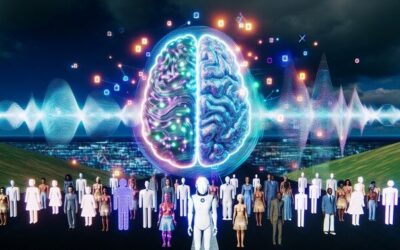History of Voice Synthesis
Voice synthesis, a technology for generating artificial speech, has evolved significantly, intertwining with advancements in artificial intelligence (AI). The history of voice synthesis dates back to the 1950s when early systems, such as the “Dudley vocoder,” were developed to convert text into speech. However, these systems produced robotic-sounding voice outputs that lacked emotional depth and naturalness.
In the 1980s, text-to-speech (TTS) technology rapidly advanced with digital signal processing, allowing for a more realistic voice generation. Notable milestones during this period include the development of concatenative synthesis, where short recordings of human speech are combined to form longer phrases, greatly improving clarity and expressiveness.
The introduction of statistical parametric speech synthesis in the 2000s marked a significant turning point. This approach, which uses algorithms to model speech waveforms, enabled even higher quality and more flexible voice synthesis. Advanced neural networks began to emerge alongside deep learning techniques, leading to dramatic improvements in the naturalness and expressiveness of synthesized voices.
The last decade has seen the rise of AI-driven TTS solutions, like Google’s WaveNet and Amazon Polly, which have utilized deep neural networks to create extraordinarily realistic speech. These systems can learn from vast amounts of data and produce voices that convey emotions, accents, and speech patterns akin to human voice modulation. Today, voice synthesis supports various applications—from virtual assistants and audiobooks to accessibility tools and entertainment [Source: Nature].
Advancements in Voice Synthesis Technology
Voice synthesis technology has evolved dramatically with advancements in neural networks and deep learning, enabling the creation of lifelike synthetic speech. At its core, voice synthesis is the process of generating human-like speech from text, relying heavily on deep learning frameworks, particularly recurrent neural networks (RNNs) and more recently, transformer architectures. These networks are trained on vast datasets of recorded speech, learning to imitate the nuances of human vocalization, including intonation, stress, and emotion.
One common method of voice synthesis is concatenative synthesis, which assembles speech from pre-recorded segments of voice, while another approach, formant synthesis, generates speech through the manipulation of sound waveforms, focusing on vowel and consonant formants. Neural network-based synthesis, particularly using models like WaveNet, has gained prominence for its ability to produce high-quality audio that sounds natural and fluid by predicting audio waveforms directly, leading to more responsive and expressive speech patterns. For a comprehensive understanding, you can explore articles that detail the intricacies of voice synthesis and related technologies further, particularly our detailed article on neural networks in voice synthesis and methods of audio processing techniques.
Applications of Voice Synthesis Technology
Voice synthesis technology is revolutionizing various industries, providing innovative solutions in gaming, education, and customer service.
In gaming, advanced AI-generated voices enhance player immersion. For example, games like *The Elder Scrolls V: Skyrim* utilize synthetic voices for non-playable characters (NPCs), creating a more dynamic and realistic interaction experience. The game’s developers used voice synthesis to simulate diverse dialogue options that adjust based on player choices, allowing for more engaging storytelling through interactive characters [Source: Gamasutra].
In education, platforms like Duolingo are harnessing voice synthesis to provide personalized language instruction. This AI technology delivers pronunciation corrections and interactive speaking practices that adapt to each learner’s progress, significantly enhancing retention and engagement [Source: EdTech Magazine].
The customer service industry is seeing a rise in AI-powered chatbots that use voice synthesis to enhance user interaction. For example, companies like Amtrak have implemented voice assistants capable of answering questions and booking tickets through natural-sounding speech, effectively reducing wait times and improving user satisfaction [Source: Forbes].
These applications showcase how voice synthesis is not only streamlining processes but also enhancing user experiences across different sectors.
Implementing Voice Synthesis in Your Projects
Implementing voice synthesis in your projects can enhance accessibility and create engaging user experiences. Here is a practical guide detailing the essential tools, libraries, and steps to create custom voice synthesis applications.
### Tools and Libraries
1. **Google Text-to-Speech**: This widely used API offers 220+ voices across 40 languages. It leverages deep learning to produce high-quality audio, making it suitable for various applications from virtual assistants to accessibility tools. Documentation is available here [Source: Google Cloud].
2. **AWS Polly**: Amazon’s service converts text to lifelike speech, offering 60 voices in 29 languages. It supports SSML (Speech Synthesis Markup Language), providing fine control over speech output. More details can be found in the AWS Polly Developer Guide [Source: Amazon Web Services].
3. **Microsoft Azure Speech Service**: This service creates natural-sounding speech from text with its neural network models. It supports various languages and dialects. Check the Azure Speech Service Overview [Source: Microsoft].
4. **OpenAI Whisper**: An open-source model for transcribing and translating speech into text, Whisper can also be adapted for voice synthesis applications. More information is available on the GitHub repository [Source: OpenAI].
5. **Festival Speech Synthesis System**: A free, open-source option that supports multiple languages and offers a customizable environment. It serves as a solid choice for academic projects. Visit Festival’s Site for more details [Source: University of Edinburgh].
### Steps to Create Custom Voice Synthesis Applications
1. **Define Project Requirements**: Determine the specific needs of your application. Consider factors such as the target audience, language support, and types of voices needed (e.g., male, female, different accents).
2. **Select the Right Tools and Libraries**: Based on your requirements, choose the appropriate APIs or libraries. For example, if you need real-time voice synthesis, consider using Google Text-to-Speech or AWS Polly for their low-latency processing capabilities.
3. **Set Up Your Development Environment**: Depending on the chosen tools, set up your development environment. This may involve installing specific SDKs or dependencies and configuring your settings.
4. **Implement Voice Synthesis Features**: Start coding by integrating the selected API or library into your application. If using AWS Polly, you might make HTTP requests to the service to fetch synthesized speech audio.
5. **Test and Refine**: Continuously test the implementation with different text inputs to ensure quality and performance. Make adjustments based on user feedback to enhance voice clarity and naturalness.
6. **Deploy and Monitor**: Once satisfied with the development, deploy your application. Monitor its usage to gather insights and refine features as necessary.
### Best Practices
– **Optimize Audio Quality**: Use high sample rates (e.g. 22 kHz or higher) for better voice quality.
– **Leverage Natural Language Processing**: Enhance the naturalness of speech synthesis by using techniques like phoneme matching or prosody adjustment.
– **Consider Accessibility**: Ensure that the synthesized voice is clear and intelligible to cater to users with hearing impairments.
– **Stay Updated with API Changes**: Continuously check for updates from your chosen tools as APIs evolve, which can enhance the functionality of your application.
By using these tools and following these steps, you can create effective voice synthesis applications that cater to your project’s needs. For further insights, explore related articles on voice technology at our website.
Ethics in Voice Synthesis
Advancements in voice synthesis technology are at the forefront of AI innovation, promising remarkable capabilities, yet they also raise significant ethical concerns. As systems become increasingly sophisticated, they can generate speech indistinguishable from human voices, leading to potential misuse in areas such as misinformation, impersonation, and deepfake audio generation. According to a report by Nature, these technologies could be manipulated to create misleading audio recordings that could damage reputations or influence public opinion through deceptive content.
The ethical implications surrounding voice synthesis involve responsible use and the safeguarding of individual rights. With the ability to recreate voices of individuals without consent, there are pressing concerns regarding privacy violations and the potential for cyberbullying. Researchers have urged the development of regulatory frameworks to oversee the deployment of such technologies. A comprehensive approach to regulation is essential, as highlighted in discussions about technology governance, which point out that existing laws may not adequately address the nuances of AI-generated content [Source: PV Magazine].
Furthermore, the rise of voice synthesis tools necessitates ongoing dialogue among stakeholders, including tech developers, legal experts, and ethicists, to mitigate risks associated with misuses of voice technology. Future policies should also prioritize transparency and accountability, ensuring that users can identify synthesized content while enabling the advancement of beneficial applications in fields like education and entertainment. To better understand the balance of innovation and ethics in voice synthesis, see our article on Ethics in Voice Technology.




